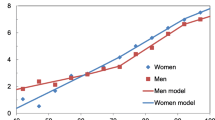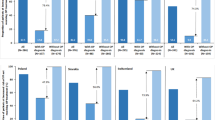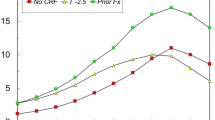Abstract
Summary
The Brazilian FRAX model is described and used to determine intervention thresholds for the treatment of osteoporosis.
Introduction
A FRAX model for Brazil was released May 1, 2013. This paper describes the data used to develop the Brazilian FRAX® model, illustrates its features and develops intervention thresholds.
Methods
Age- and sex-stratified hip fracture incidence rates were extracted from four regional estimates from the age of 40 years. For other major fractures, Brazilian incidence rates were estimated using Swedish ratios for hip to other major osteoporotic fracture (humerus, forearm or clinical vertebral fractures). Assessment and intervention thresholds were determined using the approach recommended by the National Osteoporosis Guideline Group (UK) applied to the Brazilian FRAX model.
Results
Fracture incidence rates increased with increasing age: for hip fracture, incidence rates were higher amongst younger men than women but with a female preponderance from the age of 50 years. Ten-year probability of hip or major fracture was increased in patients with a clinical risk factor, lower BMI, female gender, a higher age and a decreased BMD T-score. Of the clinical risk factors, prior fracture accounted for the greatest increase in 10-year fracture probability at younger ages while a parental hip fracture history was the strongest risk factor at ages 80–90 years. Age-dependent probability-based intervention thresholds were developed equivalent to women with a prior fragility fracture.
Conclusions
The FRAX tool is the first to provide a country-specific fracture prediction model for Brazil. It is based on the original FRAX methodology, which has been externally validated in several independent cohorts. Despite some limitations, the strengths make the Brazilian FRAX tool a good candidate for implementation into clinical practice.




Similar content being viewed by others
References
Kanis JA, Johansson H, Oden A, Cooper C, McCloskey EV, the Epidemiology and Quality of Life Working Group of IOF (2013) Worldwide uptake of FRAX. Arch Osteoporos 8:166
Kanis JA on behalf of the World Health Organization Scientific Group (2008) Assessment of osteoporosis at the primary health-care level. Technical Report. WHO Collaborating Centre, University of Sheffield, UK. Accessible at http://www.shef.ac.uk/FRAX. Accessed 26th February 2015
Kanis JA, Johnell O, Oden A, Johansson H, McCloskey EV (2008) FRAX™ and the assessment of fracture probability in men and women from the UK. Osteoporos Int 19:385–397
Kanis JA, Oden A, Johnell O, Johansson H, De Laet C, Brown J et al (2007) The use of clinical risk factors enhances the performance of BMD in the prediction of hip and osteoporotic fractures in men and women. Osteoporos Int 18:1033–1046
Kanis JA, Odén A, McCloskey EV, Johansson H, Wahl D, Cyrus Cooper C on behalf of the IOF Working Group on Epidemiology and Quality of Life (2012) A systematic review of hip fracture incidence and probability of fracture worldwide. Osteoporos Int 23:2239–2256
Elffors I, Allander E, Kanis JA, Gullberg B, Johnell O, Dequeker J et al (1994) The variable incidence of hip fracture in southern Europe: the MEDOS study. Osteoporos Int 4:253–263
Zanchetta J, Campusano C, Musi B, Terront A, Cerdas S, Molina FC, Clark P, Messina O, Zerbini C, McDonald S (2012) The Latin America Regional Audit. Epidemiology, costs & burden of osteoporosis in 2012. International Osteoporosis Foundation, Nyon. Available at www.iofbonehealth.org
Clark P, Cons-Molina F, Delezé M, Ragi-Eis S, Haddock L, Zanchetta JR et al (2009) The prevalence of vertebral fractures in Latin American countries: the Latin-American vertebral osteoporosis study (LAVOS). Osteoporos Int 20:275–282
Castro da Rocha FA, Ribeiro AR (2013) Low incidence of hip fractures in an equatorial area. Osteoporos Int 14:496–499
Silveira VA, Medeiros MM, Coelho-Filho JM, Mota RS, Noleto JC, Costa FS et al (2005) Incidência de fratura do quadril em área urbana do Nordeste brasileir; o [Hip fracture incidence in an urban area in Northeast Brazil]. Cad Saude Publica 21(3):907–912
Komatsu RS, Ramos LR, Szejnfeld VL (2004) Incidence of proximal femur fractures in Marilia, Brazil. J Nutr Health Aging 8:362–367
Schwartz AV, Kelsey JL, Maggi S, Tuttleman M, Ho SC, Jónsson PV et al (1999) International variation in the incidence of hip fractures: cross-national project on osteoporosis for the World Health Organization program for research on aging. Osteoporos Int 1999(9):242–253
Brazilian Institute of Geography and Statistics (IBGE). Demographic Census 2000–2010 http://www.ibge.gov.br/english/#sub_populacao Accessed 11th May 2015
UN Population Division of the Department of Economic and Social Affairs of the United Nations Secretariat, World Population Prospects: The 2010 Revision, http://esa.un.org/unpd/wpp/index.htm
Kanis JA, Hans D, Cooper C, Baim S, Bilezikian JP, Binkley N et al (2011) Interpretation and use of FRAX in clinical practice. Osteoporos Int 22:395–411
Siggeirsdottir K, Aspelund T, Johansson H, Gudmundsson EF, Mogensen B, Jonsson BY et al (2014) The incidence of a first major osteoporotic fracture in Iceland and implications for FRAX. Osteoporos Int 25:2445–2451
Lam A, Leslie WD, Lix LM, Yogendran M, Morin SN, Majumdar SR (2014) Major osteoporotic to hip fracture ratios in Canadian men and women with Swedish comparisons: a population-based analysis. J Bone Miner Res 29:1067–1073
Kanis JA, McCloskey EV, Johansson H, Strom O, Borgstrom F, Oden A (2008) Case finding for the management of osteoporosis with FRAX-assessment and intervention thresholds for the UK. Osteoporos Int 19:1395–1408
Compston J, Cooper A, Cooper C, Francis R, Kanis JA, Marsh D et al (2009) Guidelines for the diagnosis and management of osteoporosis in postmenopausal women and men from the age of 50 years in the UK. Maturitas 62:105–108
Johansson H, Oden A, Johnell O, Jonsson B, de Laet C, Oglesby A et al (2004) Optimization of BMD measurements to identify high risk groups for treatment—a test analysis. J Bone Miner Res 19:906–913
Leslie WD, Majumdar SR, Lix LM, Johansson H, Oden A, McCloskey E et al (2012) High fracture probability with FRAX usually indicates densitometric osteoporosis: implications for clinical practice. Osteoporos Int 23:391–397
Kanis JA, McCloskey EV, Johansson H, Cooper C, Rizzoli R, Reginster JY (2013) European guidance for the diagnosis and management of osteoporosis in postmenopausal women. Osteoporos Int 24:23–57
Johansson H, Kanis JA, Oden A, Johnell O, McCloskey E (2009) BMD, clinical risk factors and their combination for hip fracture prevention. Osteoporos Int 20:1675–1682
Kanis JA, Oden A, Johnell O, Jonsson B, de Laet C, Dawson A (2001) The burden of osteoporotic fractures: a method for setting intervention thresholds. Osteoporosis Int 12:417–427
Acknowledgments
We are indebted with Dr. Michael R. McClung and Dr. Ghada El-Hajj Fuleihan for their friendly help and advice.
Conflicts of interest
None.
Author information
Authors and Affiliations
Corresponding author
Rights and permissions
About this article
Cite this article
Zerbini, C.A.F., Szejnfeld, V.L., Abergaria, B.H. et al. Incidence of hip fracture in Brazil and the development of a FRAX model. Arch Osteoporos 10, 28 (2015). https://doi.org/10.1007/s11657-015-0224-5
Received:
Accepted:
Published:
DOI: https://doi.org/10.1007/s11657-015-0224-5




